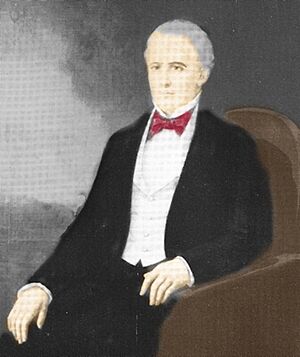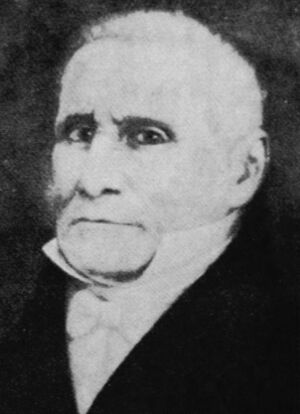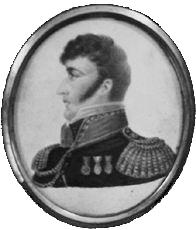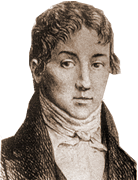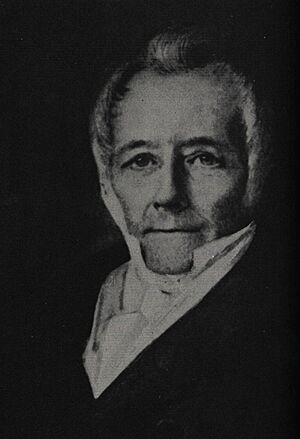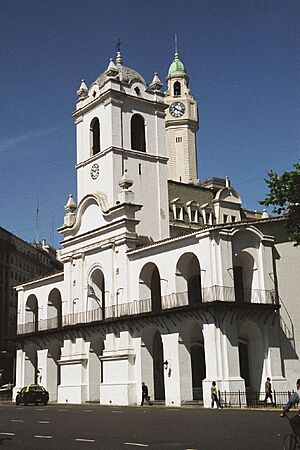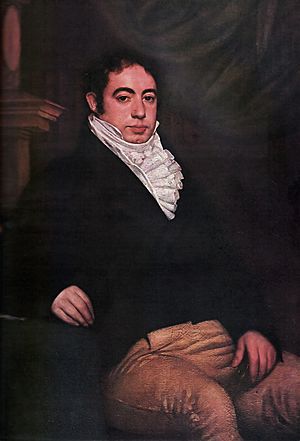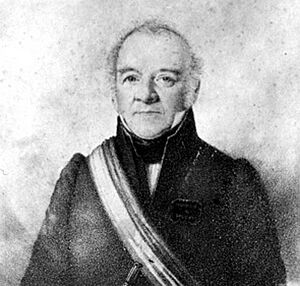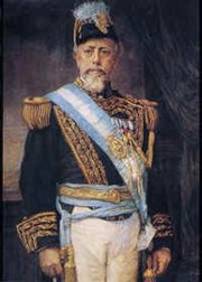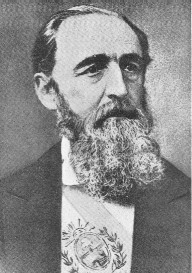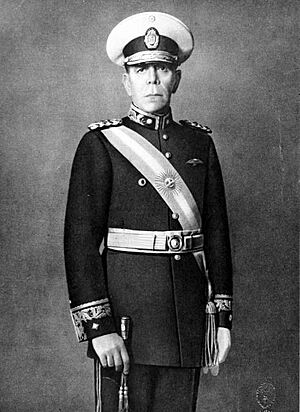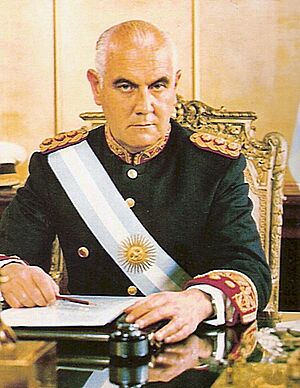List of heads of state of Argentina facts for kids
Quick facts for kids President of the Argentine Nation |
|
|---|---|

Presidential Standard
|
|
| Style | Excelentísimo Señor (m) Excelentísima Señora (f) |
| Residence | Casa Rosada (government office) Quinta de Olivos (official residence) Chapadmalal Residence (summer house) |
| Term length | Four years, renewable once |
| Inaugural holder | Bernardino Rivadavia |
| Formation | first: 1826 Constitution current: 1853 Constitution (amended in 1994). |
| Deputy | Vice President |
| Salary | AR$1,281,328 (as of December 2022) |
| Website | Office of the President |
Argentina has a rich history with many different types of leaders. Before Europeans arrived, various native groups lived there. Most did not have a single, central government. However, the Inca people in the Northwest and Cuyo regions were part of a large empire.
When the Spanish arrived, the King of Spain ruled these lands. He appointed special leaders called viceroys to govern locally. The area that is now Argentina was first part of the Viceroyalty of Peru. Later, it became part of the Viceroyalty of the Río de la Plata.
The May Revolution in 1810 began Argentina's fight for independence. This revolution replaced the Spanish viceroy with the first national government. This government was called the Primera Junta, a group of several members. It later grew into the Junta Grande as more leaders joined from different provinces.
Because these juntas had many members, they often had disagreements. So, they were replaced by smaller groups called First and Second Triumvirates, each with three members. In 1813, a new assembly created a single executive leader called the Supreme Director of the United Provinces of the Río de la Plata.
In 1816, the Congress of Tucumán officially declared independence from Spain. They also wrote a constitution in 1819. But this constitution was soon canceled because of conflicts between the central government and provinces. This led to a period known as the Anarchy of the Year XX, when Argentina had no single head of state.
In 1826, there was a new effort to create a central government. A new congress wrote another constitution and elected Bernardino Rivadavia as the first President of Argentina. However, he resigned soon after, and the 1826 Constitution was also canceled.
The Argentine provinces then formed a confederation. There was no central head of state. Instead, the governors of Buenos Aires province handled some national duties, like managing foreign relations. Juan Manuel de Rosas was a powerful governor who held this position for 17 years.
In 1852, Justo José de Urquiza defeated Rosas. Urquiza then called for a new assembly to write a constitution. This led to the Argentine Constitution of 1853, which is still the basis of Argentina's government today, with some changes. In 1854, Urquiza became the first President of modern Argentina.
However, the Buenos Aires Province initially refused to join this new government. It became an independent state for a while. After more conflicts, Bartolomé Mitre became the first president of a truly unified Argentine Republic in 1861.
Since then, Argentina has mostly had constitutional presidents. But there have been times when military leaders took control of the government without elections. These events are called military coups. The last military government ended in 1983. The current President of Argentina is Javier Milei, who took office on December 10, 2023.
Contents
Political Parties and Groups
This table shows the different political groups that leaders belonged to throughout Argentina's history.
| Abbreviation | Party name (English) | Party name (Spanish) | Years | |
|---|---|---|---|---|
| Unitarian | Unitarian Party | Partido Unitario | 1826–1827, 1828–1829 | |
| Federal | Federalist Party | Partido Federal | 1827–1828, 1829–1861 | |
| Liberal | Liberal Party | Partido Liberal | 1862–1868 | |
| — | Independent politician | Político independiente | 1868–1874 | |
| PAN | National Autonomist Party | Partido Autonomista Nacional | 1874–1916 | |
| UCR | Radical Civic Union | Unión Cívica Radical | 1916–1930, 1958–1966, 1983–1989, 1999–2003 | |
| Military | Armed Forces of the Argentine Republic | Fuerzas Armadas de la República Argentina | 1930–1932, 1943–1946, 1955–1958, 1966–1973, 1976–1983 | |
| Concordancia | Concordancia | Concordancia | 1932–1943 | |
| PJ | Justicialist Party | Partido Justicialista | 1946–1955, 1973–1976, 1989–1999, 2003–2015, 2019–2023 | |
| PRO | Republican Proposal | Propuesta Republicana | 2015–2019 | |
| PL | Libertarian Party | Partido Libertario | 2023–present | |
Early Leaders of the United Provinces (1810–1831)
Junta Presidents (1810–1811)
These were the first leaders after the May Revolution.
| Portrait | Name (Born–Died) |
Time in Office | Notes |
R. | ||
|---|---|---|---|---|---|---|
| Start | End | Days in office | ||||
| Cornelio Saavedra (1759–1829) |
25 May 1810 | 18 December 1810 | President of the Primera Junta. This was the first national government. | 217 days | ||
| 18 December 1810 | 26 August 1811 | President of the Junta Grande. He left to join the army. | 140 days | |||
| Domingo Matheu (1765–1831) |
26 August 1811 | 23 September 1811 | President of the Junta Grande until it was dissolved. | 13 days | ||
Triumvirates (1811–1814)
Triumvirates were ruling bodies made up of three people.
| First Triumvirate 23 September 1811 – 8 October 1812 |
|||
|---|---|---|---|
| 23 September 1811 – 23 March 1812 | 23 March 1812 – 8 October 1812 | ||
|
Feliciano Chiclana (1761–1826) |
|||
|
Manuel de Sarratea (1774–1849) |
|||
|
Juan José Paso (1758–1833) |
Juan Martín de Pueyrredón (1776–1850) |
||
| Second Triumvirate 8 October 1812 – 31 January 1814 |
|||
|---|---|---|---|
| 8 October 1812 – 20 February 1813 | 20 February 1813 – 19 August 1813 | 19 August 1813 – 5 November 1813 | 5 November 1813 – 31 January 1814 |
|
Nicolás Rodríguez Peña (1775–1853) |
|||
|
Antonio Álvarez Jonte (1784–1820) |
Gervasio Antonio de Posadas (1757–1833) |
||
|
Juan José Paso (1758–1833) |
José Julián Pérez (1770–1840) |
Juan Larrea (1782–1847) |
|
Supreme Directors (1814–1820)
These leaders acted as the head of state for the United Provinces.
| Portrait | Name (Born–Died) |
Time in Office | Notes | R. | ||
|---|---|---|---|---|---|---|
| Start | End | Days in office | ||||
| Gervasio Antonio de Posadas (1757–1833) |
31 January 1814 | 9 January 1815 | 343 days | Chosen by the Assembly of the Year 1813. | ||
| Carlos María de Alvear (1789–1852) |
9 January 1815 | 18 April 1815 | 99 days | Forced to resign by a rebellion. | ||
|
|
José de San Martín (1778–1850) Matías de Irigoyen (1781–1839) Manuel de Sarratea (1774–1849) |
18 April 1815 | 20 April 1815 | 2 days | A temporary government until a new Supreme Director was chosen. | |
| José Rondeau (1773–1844) |
20 April 1815 | 21 April 1815 | 1 day | Appointed but could not take office as he was leading the army. | ||
| Ignacio Álvarez Thomas (1787–1857) |
21 April 1815 | 16 April 1816 | 361 days | Acting leader for Rondeau. He called the Congress that declared Independence. | ||
| Antonio González de Balcarce (1774–1819) |
16 April 1816 | 9 July 1816 | 84 days | Interim leader. | ||
| Juan Martín de Pueyrredón (1776–1850) |
9 July 1816 | 9 June 1819 | 2 years, 335 days | First Argentine Head of State after the Argentine Declaration of Independence. He supported the famous Crossing of the Andes by General San Martín. | ||
| José Rondeau (1773–1844) |
9 June 1819 | 1 February 1820 | 237 days | His forces were defeated by federalist groups. | ||
| Juan Pedro Aguirre (1781–1837) |
1 February 1820 | 11 February 1820 | 10 days | Interim leader. He helped set up a new system for Buenos Aires. | ||
Governors of Buenos Aires Province (1820–1826)
During this time, the provinces were loosely connected. The Governor of Buenos Aires handled international matters for all of them.
| Portrait | Name (Born–Died) |
Time in Office | Notes |
R. | |
|---|---|---|---|---|---|
| Start | End | ||||
| Matías de Irigoyen (1781–1839) |
11 February 1820 | 18 February 1820 | Interim Governor. | ||
| Manuel de Sarratea (1774–1849) |
18 February 1820 | 6 March 1820 | Resigned due to political problems. | ||
| Juan Ramón Balcarce (1773–1836) |
6 March 1820 | 11 March 1820 | Interim. Resigned. | ||
| Manuel de Sarratea (1774–1849) |
11 March 1820 | 2 May 1820 | Returned to office but resigned again. | ||
| Ildefonso Ramos Mexía (1769–1854) |
2 May 1820 | 20 June 1820 | |||
| Ildefonso Ramos Mexía and Miguel Estanislao Soler | 20 June 1820 | 23 June 1820 | They shared power at the same time. | ||
| Miguel Estanislao Soler (1783–1849) |
23 June 1820 | 29 June 1820 | Took power after a rebellion, but his government was very short. | ||
| Manuel Dorrego (1787–1828) |
29 June 1820 | 20 September 1820 | Interim. | ||
| Martín Rodríguez (1771–1845) |
20 September 1820 | 2 April 1824 | Signed important treaties. | ||
| Juan Gregorio de las Heras (1780–1866) |
2 April 1824 | 7 February 1826 | He called a Congress that created a Unitary Republic. He resigned because of it. | ||
First Presidential Government (1826–1827)
This was Argentina's first attempt at having a president.
| Portrait | Name (Born–Died) |
Time in Office | Elections | Political party |
Notes |
R. | ||
|---|---|---|---|---|---|---|---|---|
| Start | End | |||||||
| Bernardino Rivadavia (1780–1845) |
8 February 1826 | 27 June 1827 | 1826 | Unitarian | Elected by the Congress. He resigned because the provinces rejected the new constitution and people were unhappy with the war. | |||
| Vicente López y Planes (1785–1856) |
7 July 1827 | 18 August 1827 | — | Chosen as temporary president. His job was to close the assembly and call for new elections. | ||||
Governors of Buenos Aires Province (1827–1831)
After the first president resigned, the Governors of Buenos Aires again managed international relations.
| Portrait | Name (Born–Died) |
Time in Office | Political party |
Notes |
R. | ||
|---|---|---|---|---|---|---|---|
| Start | End | ||||||
| Manuel Dorrego (1787–1828) |
18 August 1827 | 1 December 1828 | Federal | Ended a war. He was removed from power and executed. | |||
| Juan Lavalle (1797–1841) |
1 December 1828 | 26 June 1829 | Unitarian | Took power in a coup. He resigned when he was surrounded by enemy forces. | |||
| Juan José Viamonte (1774–1843) |
26 June 1829 | 6 December 1829 | Federal | Interim. | |||
| Juan Manuel de Rosas (1793–1877) |
6 December 1829 | 4 January 1831 | First time in office. He formed the Federal Pact and fought against the Unitarian League. | ||||
Argentine Confederation (1831–1861)
Governors Managing International Relations (1831–1852)
During this period, the governors of Buenos Aires continued to handle foreign affairs for the confederation of provinces.
| Portrait | Name (Born–Died) |
Time in Office | Political party |
Notes | R. | ||
|---|---|---|---|---|---|---|---|
| Start | End | ||||||
| Juan Manuel de Rosas (1793–1877) |
4 January 1831 | 5 December 1832 | Federal | Governor of Buenos Aires Province. Resigned. | |||
| Juan Ramón Balcarce (1773–1836) |
5 December 1832 | 4 November 1833 | Governor of Buenos Aires Province. Removed from office by a revolution. | ||||
| Juan José Viamonte (1774–1843) |
4 November 1833 | 27 June 1834 | Governor of Buenos Aires Province. Interim. | ||||
| Manuel Vicente Maza (1779–1839) |
27 June 1834 | 7 March 1835 | Governor of Buenos Aires Province. Interim. | ||||
| Juan Manuel de Rosas (1793–1877) |
7 March 1835 | 3 February 1852 | Governor of Buenos Aires Province. He was given special powers. He fought in several wars. He was defeated and resigned. | ||||
| Vicente López y Planes (1785–1856) |
3 February 1852 | 6 April 1852 | — | Governor of Buenos Aires Province. Interim. | |||
| Justo José de Urquiza (1801–1870) |
6 April 1852 | 31 May 1852 | Federal | Governor of Entre Ríos Province, in charge of foreign relations. | |||
Provisional Director of the Argentine Confederation (1852–1854)
| Portrait | Name (Born–Died) |
Time in Office | Political party |
Notes | R. | ||
|---|---|---|---|---|---|---|---|
| Start | End | ||||||
| Justo José de Urquiza (1801–1870) |
31 May 1852 | 5 March 1854 | Federal | He was also Governor of Entre Ríos and Buenos Aires for a time. The current Constitution was approved by most provinces during his time. | |||
Presidents of the Confederation (1854–1861)
These were the first presidents under the 1853 Constitution.
| Portrait | Name (Born–Died) |
Time in Office | Elections | Political party |
Notes | Vice President | R. | ||
|---|---|---|---|---|---|---|---|---|---|
| Start | End | ||||||||
| Justo José de Urquiza (1801–1870) |
5 March 1854 | 5 March 1860 | 1853 | Federal | First constitutional President of Argentina. He worked to bring Buenos Aires back into the country. | Salvador María del Carril | |||
| Santiago Derqui (1809–1867) |
5 March 1860 | 5 November 1861 | 1860 | A new constitutional reform was adopted. He resigned after his government was defeated by Buenos Aires Province. | Juan Esteban Pedernera | ||||
| Juan Esteban Pedernera (1796–1886) |
5 November 1861 | 12 December 1861 | Unitarian |
Vice President under Derqui. He became president after Derqui resigned. He also resigned when the national government dissolved. | Vacant | ||||
Argentine Republic (1861–Present)
Presidents (1861–Present)
This section lists the presidents of the unified Argentine Republic.
| Portrait | Name (Born–Died) |
Time in Office | Elections | Political party (Coalition) |
Notes | Vice President | R. | ||
|---|---|---|---|---|---|---|---|---|---|
| Start | End | ||||||||
| Bartolomé Mitre (1821–1906) |
12 December 1861 | 12 April 1862 | — | Liberal | Governor of Buenos Aires Province who took charge of the national government after a battle. Provinces gave him different powers. | Vacant | |||
| 12 April 1862 | 2 June 1862 | He declared himself "Governor of Buenos Aires Province in charge of the National Executive Power." | |||||||
| 2 June 1862 | 12 October 1862 | The National Congress officially put the Governor of Buenos Aires in charge until elections. | |||||||
| 12 October 1862 | 12 October 1868 | 1862 | Liberal Nacionalist |
First president of the unified country. He led Argentina during the War of the Triple Alliance. | Marcos Paz (Died 2 January 1868) Acting President of Argentina from 12 June 1865 until 2 January 1868. |
||||
| Vacant | |||||||||
| Domingo Faustino Sarmiento (1811–1888) |
12 October 1868 | 12 October 1874 | 1868 | — | He ended the War of the Triple Alliance. | Adolfo Alsina | |||
| Nicolás Avellaneda (1837–1885) |
12 October 1874 | 12 October 1880 | 1874 | National ↓ PAN |
During his term, Buenos Aires City became the capital of Argentina. | Mariano Acosta | |||
| Julio Argentino Roca (1843–1914) |
12 October 1880 | 12 October 1886 | 1880 | PAN | First term. The Argentine Civil Wars ended during his time. | Francisco Bernabé Madero | |||
| Miguel Ángel Juárez Celman (1844–1909) |
12 October 1886 | 6 August 1890 | 1886 | PAN | He resigned after a revolution. | Carlos Pellegrini | |||
| Carlos Pellegrini (1846–1906) |
6 August 1890 | 12 October 1892 | PAN | Vice President under Juárez Celman. He became president after Juárez Celman resigned. | Vacant | ||||
| Luis Sáenz Peña (1822–1907) |
12 October 1892 | 22 January 1895 | 1892 | PAN | He resigned. | José Evaristo Uriburu | |||
| José Evaristo Uriburu (1831–1914) |
22 January 1895 | 12 October 1898 | PAN | Vice President under Sáenz Peña. He became president after Sáenz Peña resigned. | Vacant | ||||
| Julio Argentino Roca (1843–1914) |
12 October 1898 | 12 October 1904 | 1898 | PAN | Second term. | Norberto Quirno Costa | |||
| Manuel Quintana (1835–1906) |
12 October 1904 | 12 March 1906 † | 1904 | PAN | He died in office. | José Figueroa Alcorta | |||
| José Figueroa Alcorta (1860–1931) |
25 January 1906 | 12 March 1906 | PAN | Vice President under Quintana. He was acting president during Quintana's illness. | Himself | ||||
| 12 March 1906 | 12 October 1910 | Vice President under Quintana. He became president after Quintana's death. | Vacant | ||||||
| Roque Sáenz Peña (1851–1914) |
12 October 1910 | 9 August 1914 † | 1910 | PAN Modernist |
He introduced a law that made voting secret, universal, and mandatory. He died in office. | Victorino de la Plaza | |||
| Victorino de la Plaza (1840–1919) |
9 August 1914 | 12 October 1916 | PAN | Vice President under Sáenz Peña. He became president after Sáenz Peña's death. | Vacant | ||||
| Hipólito Yrigoyen (1852–1933) |
12 October 1916 | 12 October 1922 | 1916 | UCR | First president elected under the new voting law. First term. Argentina remained neutral during World War I. | Pelagio Luna (Died 25 June 1919) |
|||
| Vacant | |||||||||
| Marcelo Torcuato de Alvear (1868–1942) |
12 October 1922 | 12 October 1928 | 1922 | UCR | Elected in free elections. | Elpidio González | |||
| Hipólito Yrigoyen (1852–1933) |
12 October 1928 | 6 September 1930 | 1928 | UCR | Second term. He was removed from office by a military coup. | Enrique Martínez | |||
| Enrique Martínez (1887–1938) |
5 September 1930 | 6 September 1930 | — | UCR | Vice President under Yrigoyen. He was acting president during Yrigoyen's illness. He was removed from office by a military coup. | Himself | |||
| José Félix Uriburu (1868–1932) |
6 September 1930 | 20 February 1932 | — | Military (ALN) |
This was the first military coup in modern Argentina. He called for new elections. | Enrique Santamarina (Resigned 20 October 1930) |
|||
| Vacant | |||||||||
| Agustín Pedro Justo (1876–1943) |
20 February 1932 | 20 February 1938 | 1931 | UCR-A (Concordancia) |
Elections were held with some unfair practices, and a major political party was not allowed to participate. | Julio Argentino Pascual Roca | |||
| Roberto Marcelino Ortiz (1886–1942) |
20 February 1938 | 27 June 1942 | 1937 | UCR-A (Concordancia) |
Elections were held with some unfair practices. He resigned due to health issues and died a month later. | Ramón Castillo | |||
| Ramón Castillo (1873–1944) |
3 July 1940 | 27 June 1942 | PDN (Concordancia) |
Vice President under Ortiz. He was acting president during Ortiz's illness. | Himself | ||||
| 27 June 1942 | 4 June 1943 | Vice President of Ortiz. He became president after Ortiz resigned. He was removed from office by a military coup. | Vacant | ||||||
| Arturo Rawson (1885–1952) |
4 June 1943 | 7 June 1943 | — | Military (GOU–affiliated) |
He took power in a military coup but was removed shortly after. | ||||
| Pedro Pablo Ramírez (1884–1962) |
7 June 1943 | 9 March 1944 | — | Military (GOU–affiliated) |
He took power in a military coup. He resigned. | Sabá Sueyro (Died 15 October 1943) |
|||
| Edelmiro Julián Farrell | |||||||||
| Edelmiro Julián Farrell (1887–1980) |
25 February 1944 | 9 March 1944 | — | Military (GOU–affiliated) |
Vice President under Ramírez. He was acting president. | Himself | |||
| 9 March 1944 | 4 June 1946 | He declared war on the Axis powers during World War II. He called for elections. | Vacant | ||||||
| Juan Perón (8 July 1944–10 October 1945) |
|||||||||
| Juan Pistarini | |||||||||
| Juan Perón (1895–1974) |
4 June 1946 | 4 June 1952 | 1946 | Labour (UCR-JR) (Independent Party) |
First term. The constitution was changed to allow him to be reelected. | Hortensio Quijano (Died 3 April 1952) |
|||
| Vacant | |||||||||
| 4 June 1952 | 21 September 1955 | 1951 | Peronist | Second term. This was the first election where women could vote. He was removed from office by a military coup. | |||||
| Alberto Teisaire (7 May 1954–16 September 1955) |
|||||||||
| Vacant | |||||||||
| Eduardo Lonardi (1896–1956) |
16 September 1955 | 23 September 1955 | — | Military | He took power in a military coup. He declared himself "Provisional President." | ||||
| 23 September 1955 | 13 November 1955 | Lonardi was sworn in as president. He was removed from office. | Isaac Rojas | ||||||
| Pedro Eugenio Aramburu (1903–1970) |
13 November 1955 | 1 May 1958 | — | Military | He took power in a military coup. The 1949 Constitution was canceled, and the 1853 Constitution was brought back. He called for elections, but a major political party was not allowed to participate. | ||||
| Arturo Frondizi (1908–1995) |
1 May 1958 | 29 March 1962 | 1958 | UCRI | Elected in elections where a major political party was not allowed to participate. He was removed from office by a military coup. | Alejandro Gómez (Resigned 18 November 1958) |
|||
| Vacant | |||||||||
| José María Guido (1910–1975) |
29 March 1962 | 12 October 1963 | — | UCRI | He was the head of the Senate and took over as acting president after the previous president was removed. | ||||
| Arturo Umberto Illia (1900–1983) |
12 October 1963 | 28 June 1966 | 1963 | UCRP | Elected in elections where a major political party was not allowed to participate. He was removed from office by a military coup. | Carlos Humberto Perette | |||
| Junta of Commanders of the Armed Forces | 28 June 1966 | 29 June 1966 | — | Military |
This military group took power in a coup. Its members were:
|
Vacant | |||
| Juan Carlos Onganía (1914–1995) |
29 June 1966 | 8 June 1970 | — | Military | He took power in a military coup. He was later removed from office. | ||||
| Junta of Commanders of the Armed Forces | 8 June 1970 | 18 June 1970 | — | Military |
This military group took power in a coup. Its members were:
|
||||
| Roberto Marcelo Levingston (1920–2015) |
18 June 1970 | 23 March 1971 | — | Military | Appointed by the military group. He was removed from office. | ||||
| Junta of Commanders of the Armed Forces | 23 March 1971 | 26 March 1971 | — | Military |
This military group took power in a coup. Its members were:
|
||||
| Alejandro Agustín Lanusse (1918–1996) |
26 March 1971 | 25 May 1973 | — | Military | Appointed by the military group. He called for elections and allowed a major political party to participate again. | ||||
| Héctor José Cámpora (1909–1980) |
25 May 1973 | 13 July 1973 | March 1973 |
PJ (FREJULI) |
Elected in free elections. He removed the ban on a major political party's leader and then resigned. | Vicente Solano Lima | |||
| Raúl Alberto Lastiri (1915–1978) |
13 July 1973 | 12 October 1973 | — | PJ (FREJULI) |
He was the head of the Chamber of Deputies and took over as acting president. | Vacant | |||
| Juan Perón (1895–1974) |
12 October 1973 | 1 July 1974 † | Sept. 1973 |
PJ (FREJULI) |
Third term. He died in office. | Isabel Perón | |||
| Isabel Perón (born 1931) |
29 June 1974 | 1 July 1974 | PJ (FREJULI) |
First Lady and Vice President under Juan Perón. She was acting president during his illness. | Herself | ||||
| 1 July 1974 | 24 March 1976 | Vice President of Juan Perón. She became president after his death. She was the first female president in the Americas. She was removed from office by a military coup. | Vacant | ||||||
| Military Junta | 24 March 1976 | 29 March 1976 | — | Military |
This military group took power in a coup. Its members were:
|
||||
| Jorge Rafael Videla (1925–2013) |
29 March 1976 | 29 March 1981 | — | Military | He took power in a military coup. He was the longest-serving military ruler. | ||||
| Roberto Eduardo Viola (1924–1994) |
29 March 1981 | 11 December 1981 | — | Military | Appointed by the military group. His powers were suspended due to health problems. He was removed from office. | ||||
| Horacio Tomás Liendo (1924–2007) |
21 November 1981 | 11 December 1981 | — | Military | Appointed by the military group. He was acting president during Viola's suspension. | ||||
| Carlos Lacoste (1929–2004) |
11 December 1981 | 22 December 1981 | — | Military | Appointed by the military group. Interim. | ||||
| Leopoldo Galtieri (1926–2003) |
22 December 1981 | 18 June 1982 | — | Military | Appointed by the military group. He led Argentina during the Falklands War. He was removed from office. | ||||
| Alfredo Oscar Saint Jean (1926–1987) |
18 June 1982 | 1 July 1982 | — | Military | Appointed by the military group. Interim. | ||||
| Reynaldo Bignone (1928–2018) |
1 July 1982 | 10 December 1983 | — | Military | Appointed by the military group. He called for elections, ending the military rule. | ||||
| (Presidency) Raúl Alfonsín (1927–2009) |
10 December 1983 | 8 July 1989 | 1983 | UCR | Elected in free elections. He resigned early to allow the next president to take office sooner. | Víctor Hipólito Martínez | |||
| (Presidency) Carlos Menem (1930–2021) |
8 July 1989 | 8 July 1995 | 1989 | PJ (FREJUPO) |
First term. The constitution was changed in 1994 to shorten the presidential term and allow one reelection. | Eduardo Duhalde (Resigned 10 December 1991) |
|||
| Vacant | |||||||||
| 8 July 1995 | 10 December 1999 | 1995 | PJ (UCeDe) |
Second term. His term was extended to December 10, 1999, due to the 1994 constitutional change. | Carlos Ruckauf | ||||
| (Presidency) Fernando de la Rúa (1937–2019) |
10 December 1999 | 21 December 2001 | 1999 | UCR (Alianza) |
He faced a big economic crisis. He resigned after protests. Since his Vice President had resigned earlier, Congress chose a new president. | Carlos Álvarez (Resigned 6 October 2000) |
|||
| Vacant | |||||||||
| Ramón Puerta (born 1951) |
21 December 2001 | 23 December 2001 | — | PJ | He was the head of the Senate and took over as acting president for a very short time. | ||||
| Adolfo Rodríguez Saá (born 1947) |
23 December 2001 | 30 December 2001 | — | PJ | Elected by Congress for three months, but he resigned. | ||||
| Eduardo Camaño (born 1946) |
30 December 2001 | 2 January 2002 | — | PJ | He was the head of the Chamber of Deputies and took over as acting president. | ||||
| Eduardo Duhalde (born 1941) |
2 January 2002 | 25 May 2003 | — | PJ | Elected by Congress to finish the previous president's term. He called for early elections. | ||||
| (Presidency) Néstor Kirchner (1950–2010) |
25 May 2003 | 10 December 2007 | 2003 | PJ (FPV) |
Elected in free elections. He finished the previous term and then started his own. | Daniel Scioli | |||
| (Presidency) Cristina Fernández de Kirchner (born 1953) |
10 December 2007 | 10 December 2011 | 2007 | PJ (FPV) |
First term. She was the first elected female president of Argentina. | Julio Cobos | |||
| 10 December 2011 | 10 December 2015 | 2011 | PJ (FPV) |
Second term. Her term officially ended at midnight on December 9, 2015. | Amado Boudou | ||||
| Federico Pinedo (born 1955) |
10 December 2015 | — | PRO (Cambiemos) |
He was the head of the Senate and acted as president for a few hours until the new president was sworn in. | Vacant | ||||
| (Presidency) Mauricio Macri (born 1959) |
10 December 2015 | 10 December 2019 | 2015 | PRO (Cambiemos) |
First president elected in a second round of voting. He officially took office after being sworn in. | Gabriela Michetti | |||
| (Presidency) Alberto Fernández (born 1959) |
10 December 2019 | 10 December 2023 | 2019 | PJ (FdT) |
Elected in free elections. | Cristina Fernández de Kirchner | |||
| (Presidency) Javier Milei (born 1970) |
10 December 2023 | Incumbent | 2023 | PL (LLA) |
Elected in free elections. He is the first libertarian head of state in the world. | Victoria Villarruel | |||
|
See also
- President of Argentina
- Politics of Argentina
- List of vice presidents of Argentina
- Lists of incumbents




